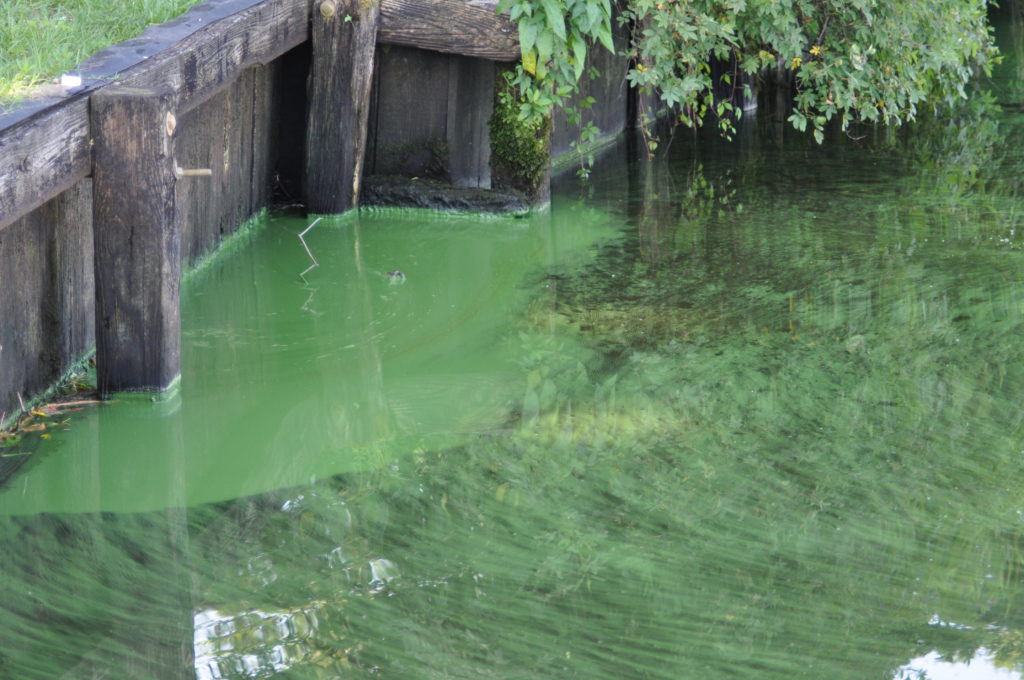
You live in a region surrounded by water. Throughout North Carolina’s history, the Albemarle Sound has been important to the people living near its rivers and streams. Today, many of your friends and family use the waterways for fishing and recreation. Visitors to the Albemarle area photograph the beauty of the stately cypress trees growing in these shallow waters as the sun sets over these rich waters.
The Chowan River is home for a diverse group of freshwater plants and animals. In some years, more salt water from the Albemarle Sound moves below the surface freshwater far up the river making a pathway for marine crabs and fish. As with all aquatic ecosystems, the Chowan River supports a complex food web with small microscopic plankton as the primary producers of food and oxygen from carbon dioxide, water and sunlight.
The microscopic “green” organisms are an important part of the view as you look into the river. Each cell has to be magnified many times to be visible; yet all together, these algal cells can color the water. Most algae are green because of their chloroplasts that are needed for photosynthesis, but some algal cells in the water are blue-green in color. These microscopic cells are commonly called blue-green algae, although they are not algae, but rather bacteria. Scientists call these organisms by a special name to remember as you look into your river – cyanobacteria (cyan = blue-green).
Cyanobacteria in the Albemarle-Pamlico Sound
The cyanobacteria are a very ancient group of organisms. They live in many different waterways across the planet but are most successful when they have sunlight, plenty of nutrients and warm water temperatures. When the cyanobacteria grow and reproduce very quickly, they create algal blooms that can cause changes in the quality of water in the river. The water can become clumpy and thick with many of these cells, smelly as the cells start to die, and can become unsafe for swimming as the cells may release chemicals into the water that are harmful to animals and humans. This is not what you want to see when you look into your river.

The Harmful Algal Blooms (HAB’s) are rapidly becoming a problem in every state and in many different types of waterways. Research universities and communities are working together to understand the causes of the more frequent harmful algal blooms.
Everyone can help especially those people that are close enough to actually look at the river and make good observations. Citizen scientists collect water samples and use digital microscopes to view, identify and photograph these algal cells in many locations. They help the research scientists by providing very specific information about the kinds of cyanobacteria that are in the water; the types and quantity of the cells can vary by season and can be also influenced by wind direction, rainfall and other environmental conditions.
Some algal ecologists refer to several commonly found cyanobacteria as Annie, Fannie and Mike to make their scientific names easier to remember. Annie is Anabaena (although this genus has now been renamed, Mike is Microcystis and Fannie is Aphanizomenon. These cyanobacteria can upset the natural balance of a waterway when they multiply quickly. The water will turn a turquoise blue color and smell strange; dead fish may be floating on the surface because of low oxygen, and the waterways can become unsafe for swimming.

The genus Anabaena (now called Dolichospermum) is one group of blue-green algae that we see in our local waterways. These cells have a special ability to make their own food (nitrogen) when there are insufficient amounts of this “plant food” for them to continue to multiply in the water. Generally, algal blooms occur when the air and water temperatures are warm, when there is low wind action and little current. Bays and small coves along a coastline are often places where the blue-green algae multiply rapidly and form blooms. These blooms can spread very quickly away from the shoreline and into open water.
We all want to keep our valuable water resources free from HAB’s and other pollutants. Step up as a community leader to encourage local action to reduce and/or effectively manage nutrient runoff into the waters, educate others about the issue, and support water quality research efforts (the only way we are going to learn more about how to decrease bloom events).
